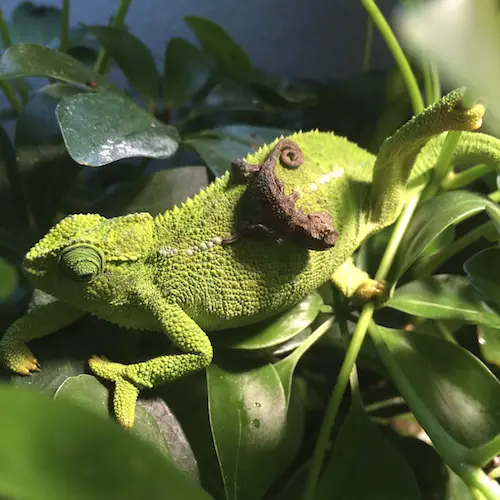
A Comprehensive Guide to Nurturing Baby Chameleons: Essential Care for Thriving Juveniles
Baby chameleons, with their captivating eyes and vibrant colors, are fascinating creatures that require specialized care to thrive. Understanding their unique needs and providing an optimal environment is crucial for their well-being and longevity. This comprehensive guide will delve into the essential aspects of baby chameleon care, empowering you to create a nurturing habitat and ensure their optimal growth and development.
1. Habitat Essentials: Creating a Home for Your Baby Chameleon
-
Enclosure: Select a spacious enclosure that provides ample room for movement and exploration. A mesh or screened enclosure allows for proper ventilation and mimics their natural habitat. The enclosure should be tall enough to accommodate climbing and provide vertical space.
-
Substrate: Choose a substrate that mimics their natural environment, such as a mixture of soil, sand, and leaf litter. Avoid using substrates that retain moisture, as they can promote bacterial growth.
-
Lighting: Provide a combination of UVB and UVA lighting to replicate natural sunlight. UVB lighting is essential for calcium absorption and bone development, while UVA lighting supports overall well-being and activity levels.
-
Temperature and Humidity: Baby chameleons require a temperature gradient within their enclosure. Create a warm basking spot of 85-90°F (29-32°C) and a cooler area of 75-80°F (24-27°C). Maintain humidity levels between 60-80% by misting the enclosure regularly or using a humidifier.
2. Nutrition: Fueling Your Baby Chameleon’s Growth
-
Diet: Baby chameleons are primarily insectivores, requiring a diet rich in live insects. Offer a variety of insects, such as crickets, mealworms, and dubia roaches, dusted with calcium and vitamin supplements.
-
Feeding Frequency: Feed baby chameleons daily, offering as many insects as they can consume within 10-15 minutes. As they grow, gradually reduce the feeding frequency to every other day or even less.
-
Hydration: Provide a constant source of fresh water in a shallow dish or dripper. Misting the enclosure regularly also helps maintain hydration.
3. Health and Hygiene: Maintaining Your Baby Chameleon’s Well-being
-
Shedding: Baby chameleons shed their skin regularly as they grow. Provide a humid environment and a rough surface for them to rub against to facilitate shedding.
-
Parasites: Regularly check for parasites, such as mites or worms, and treat them promptly with appropriate medications prescribed by a veterinarian.
-
Illnesses: Monitor your baby chameleon for any signs of illness, such as lethargy, loss of appetite, or discharge from the eyes or nose. Consult a veterinarian immediately if you suspect any health issues.
4. Handling and Socialization: Interacting with Your Baby Chameleon
-
Handling: Handle baby chameleons gently and infrequently, as excessive handling can stress them. Support their body fully and avoid squeezing or holding them upside down.
-
Socialization: Baby chameleons are solitary creatures and do not require socialization with other chameleons. However, providing them with a stimulating environment with plenty of hiding places and enrichment activities can promote their well-being.
5. Growth and Development: Monitoring Your Baby Chameleon’s Progress
-
Growth Rate: Baby chameleons grow rapidly during their first few months. Monitor their weight and size regularly to ensure they are growing at a healthy rate.
-
Behavioral Changes: As baby chameleons mature, they may exhibit changes in behavior, such as increased activity levels and a desire to explore their surroundings.
-
Sexual Maturity: Baby chameleons reach sexual maturity at different ages depending on the species. It is important to separate males and females once they reach maturity to prevent unwanted breeding.
Conclusion
Nurturing baby chameleons requires a dedicated commitment to providing a suitable habitat, nutrition, and healthcare. By understanding their unique needs and following the guidelines outlined in this comprehensive guide, you can create an optimal environment for your baby chameleon to thrive and reach its full potential. Remember to consult a veterinarian for any health concerns or specific care recommendations for your particular species. With patience, care, and a deep appreciation for these fascinating creatures, you can provide a nurturing home for your baby chameleon and witness its remarkable growth and development.
